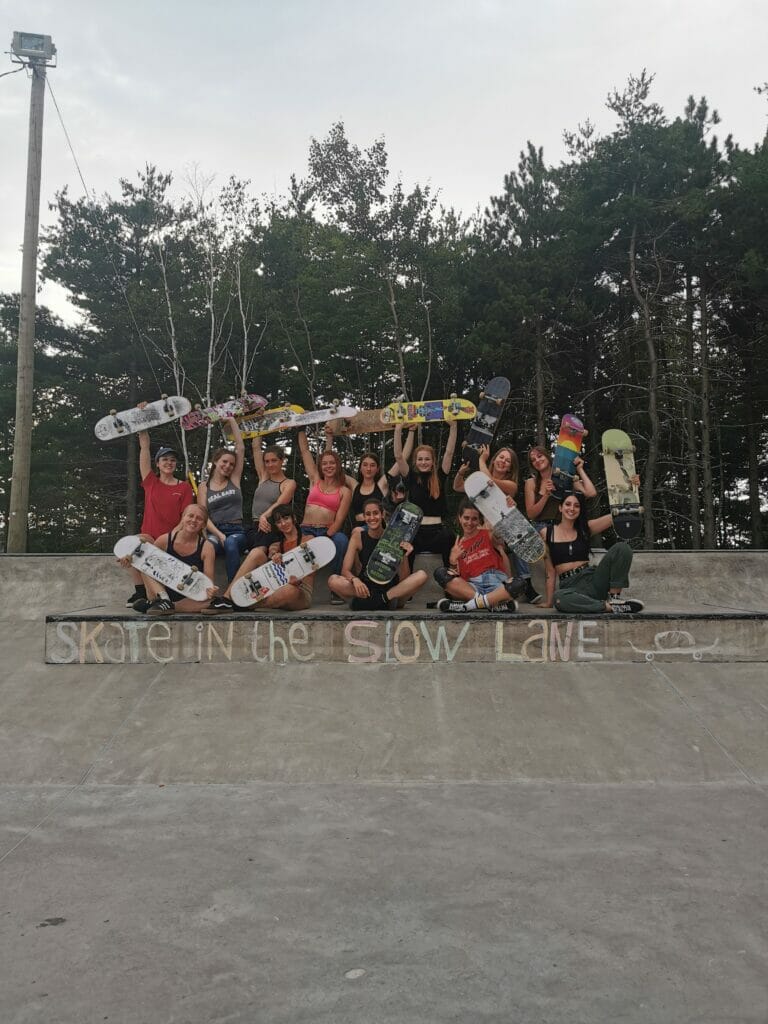
Skating in the slow lane
All-girl skate crew aims to diversify skateboarding scene in Nova Scotia
Close your eyes and imagine seeing a skateboarder. Are you picturing a white guy? Katie Mott and her group of gal pals are looking to change that narrative.
Getting started
Along with her friend Willow Star, in spring 2019 Mott co-founded Skate in the Slow Lane, a skateboarding group for women and girls in Nova Scotia.
“We were just kind of joking around about how slow we were. We really couldn’t skate at the start,” says Mott referring to the name of the group.

Mott and Star began posting photos and videos on Instagram as a way to document their progress, but what started as a casual get-together between the two quickly developed into much more.
Mott’s first encounter with skateboarding was walking into Homegrown Skateboards, a skate shop in LaHave, N.S., where she says she was welcomed with open arms. Upon watching Homegrown regulars skate, Mott was hooked.
“I had actually seen a girl skate really good for the first time in my life, and I was like, I really want to do this,” Mott says. “I started skating everywhere, all the time, as much as I could with anyone I could find. It just exploded.”
Though Mott says her experiences with skateboarding have been nothing but positive, she understands that’s not the case for all non-male skaters. Mott credits Homegrown’s “grassroots, local scene” for making her feel at home, saying the male staff are “the most inclusive, supportive men [she’s] ever met.”
“I’m very lucky and I know it’s not like this for everyone ’cause I’ve talked to people who haven’t been introduced to skateboarding the way I have,” says Mott.
Co-founder Star says some male skaters “would make fun or just constantly explain things” to her.
Star says, “I found most of learning to skate is just trying things, and so constant advice is often annoying and is often just a way for guys to hit on you, which is even more frustrating.”
A skateboarding renaissance
In comparison with other sports, skateboarding is relatively new. The sport originated in the late 1940s and gained popularity in the ’70s. By 2001, more American kids skateboarded than played baseball. Recently, increased interest in skate brands like Vans, Thrasher and Supreme, along with an influx of skate movies (Mid90s and Minding the Gap), have jump-started a sort of skateboarding renaissance.
“Everything expands. The genre’s gonna grow, the scene’s gonna grow and it should, naturally. It should progress,” says Mott.
As the culture grows and the fan base diversifies, it creates more opportunities for underrepresented groups like female and nonbinary skaters.
“It’s important to have all different kinds of people skating ’cause it invites other people to join! I for sure felt intimidated by skating with only guys,” Star says. Star also designs and produces upcycled apparel and her latest collection is inspired by gender diversity in the skate scene.
“My most recent run of prints says ‘skateboarding has no gender’ because I feel it’s important not to assign a gender to skateboarding. It’s for everyone,” says Star.
Throughout the years, skateboarding has been promoted as a male sport with mainstream media rarely highlighting non-male skaters. In the past few years, media representation has somewhat improved due in part to the Oscar-winning documentary short Learning to Skateboard in a Warzone (If You’re a Girl) and teen drama Skate Kitchen, which both focus on female skateboarders. As Mott says, “It takes time, but it’s getting better.”
Mott points out The Berrics (a skatepark in California) as an example of the progressive changes in the skateboarding world. The Berrics has been featuring more female skaters on their Instagram page as of late. But even today, backlash exists, as evidenced by the hate comments on The Berrics’ page.
“These male skaters, their whole life, have had tools to help them,” Mott says. “Bros the whole way, cheering them on, showing them the way. Female skaters will show up, they have less support, less information, and they’re still doing it. . . I worked my way here just like you did.”
Similarly, Skate in the Slow Lane’s Instagram page has been making waves especially among Nova Scotia’s youngest skaters.
“Social media isn’t everything, but it has a lot of influence especially on younger generations,” says Mott. She recalls meeting a 10-year-old girl who, upon watching videos of the Slow Lane girls, was inspired to take up skateboarding.
“To actually have that influence in real life. . . is just insane,” Mott says.
Open to everyone
Mott estimates there are around 30 skaters who regularly attend Skate in the Slow Lane events, with 10 core members in the group. Skill levels vary, and ages range from 15 to 35. Though the group has grown in size, they still maintain a casual, welcoming atmosphere for anyone who wants to drop by.
“There’s always someone starting. There’s always someone on your level,” says Mott. “It’s super motivating. . . We feed off each other’s energy.”
For anyone who wants to start skateboarding (especially those who might not see themselves represented in the sport and culture), Mott’s advice is simple:
“Show up! People are a lot nicer than you think and a lot more willing to help than you imagine. It’s intimidating for sure, but the payoff is amazing. . . do what you wanna do. Hold ground. Hold space.”
In true skater girl fashion, Mott recommends saying “Fuck you” to the haters.
“Don’t be afraid to just send it,” Mott says.






